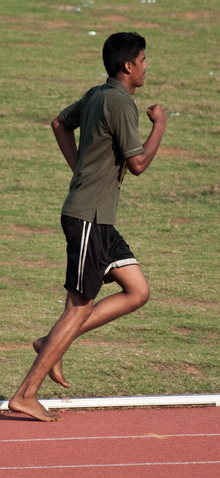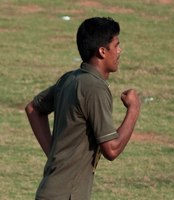St. Thomas women’s cross-country coach Joe Sweeney experienced impact-related injuries while competing in college. He turned to barefoot running to relieve some of the stress to his legs and feet.
“I got injured wearing shoes with pounding on the pavement. You can get shin problems. When I took my shoes off, it just didn’t hurt as much,” Sweeney said. “It got me thinking, ‘Wow, maybe this is something that would really benefit my legs.’”

A group of Harvard professors found that returning to a more natural technique for exercise helps prevent some of the injuries runners are facing. The technique is as simple as slipping out of your running shoes and hitting the path barefoot.
“Humans have engaged in endurance running for millions of years, but the modern running shoe was not invented until the 1970s,” the Harvard study states.
Researchers studied three groups of runners: people who had always run barefoot, people who had always run with shoes and people who had switched from shoes to barefoot. They used 3-D infrared tracking to record the strike pattern of the runners.
The group’s results show that 75 to 80 percent of those who wear shoes land heel-first. Most barefoot runners, however, land toward the front of their feet, causing less impact. Landing on one’s heel exerts 1.5 to 3 times a person’s body weight.
“Fore-foot- and mid-foot-strike gaits were probably more common when humans ran barefoot or in minimal shoes, and may protect the feet and lower limbs from some of the impact-related injuries now experienced by a high percentage of runners,” the study states.
Sweeney said he primarily ran barefoot during races, but occasionally trained barefoot as well. He said finding a place to run poses the biggest problem to those wanting to run barefoot.
“I don’t know anybody who is doing it. It really isn’t conducive to our area in terms of what we have available to us. Too many hard surfaces,” he said. “I don’t know if it’s just happening in warmer climates where there is a lot of grass to run on.”
Sweeney said he currently does not coach any athletes who run barefoot, but he said he has been tempted to encourage it in some cases. For example, at a national meet about four years ago, Sweeney’s team was forced to run a race in ankle-deep mud.
“I was so tempted to say, ‘Just take off your shoes. Let’s give it a shot,’” he said.
Sophomore cross country runner Kelsey Gantzer has also tried barefoot running in the past. In high school, her team would run barefoot on the football field after practice.
“We did it to build up strength in our feet and legs,” Gantzer said. “Sometimes if your legs or feet are tired and you take off your shoes, you feel refreshed.”
Sweeney said many shoe companies are moving toward barefoot running. Companies such as Nike have developed light, flexible shoes that Sweeney said are “a move in the right direction.”
Other companies have fully embraced the barefoot running trend, such as Vibram’s Fivefingers, a sock-like invention with a thin rubber sole for protection from debris.
“I know some runners who buy these special shoes that look like toe-socks,” Gantzer said. “They are supposed to be like [running] barefoot but protect your feet from sticks and rocks.”
Gantzer said she has seen an increase in the popularity of barefoot running.
“It’s definitely something that’s very big right now,” she said. “It’s in a lot of running magazines, and there are a lot of special shoes out.”
Maggie Clemensen can be reached at clem0427@stthomas.edu.




I’ve been barefooting for years now. I’ve got a couple pairs of Fivefingers for more dicey surfaces, but I mostly just go free with my toes in the wind. It’s one of the reasons I most look forward to this time of year through October or so. Being barefoot is more than just good for your body, I’ve found it’s great for the soul. You have to pay a little more attention to every step you take, you notice more in your daily surroundings when you have that constant reminder to pay attention to this moment.
Unfortunately, some people have a bit of a problem with this – so I’ve been forced to carry around some backup-sandals in my bag. And it does take some getting used to – after months of Winter’s boot-mandate, the callus fades and your legs forget how it feels. So the first week or two take a little adjustment as it all toughens back up – but once you’re comfortable with it, it does wonders.
This concept was explored in the 2009 best-seller “Born To Run” by Christopher McDougall. He documents his own search for injury-free running, telling the story of a native tribe in Mexico that runs everywhere, and easily beats top marathoners—barefoot. Physiology does explain why the human foot is shaped the way it is. Check it out!
I’ve been wearing Five Fingers for several months, doing short runs and weightlifting in them and I absolutely love them. The first few weeks of using them make your ankles and calves pretty sore, but afterwards it feels great to run.
Another wa to prep the ankles for barefoot running is wearing the traditional Japanese wooded sandals (geta), which initially require constant adjustments in balance & weight distribution until you get used to them. In more modern fashion, try working out on the Cybex ARC Trainer (other “ellipticals” have funny marching-band type motions, so I can’t verify this as good there) with only the front half of your foot (shod or bare) on the pedals. Make certain your foot is well-positioned not to slip—you might gradually work up to the “half-off” position. The ARC works the lifting (quads), but also engages the ankle/calf muscles when more flex is allowed by leaving the heel “off” the pedal. BTW, this is also good even if you already run barefoot.